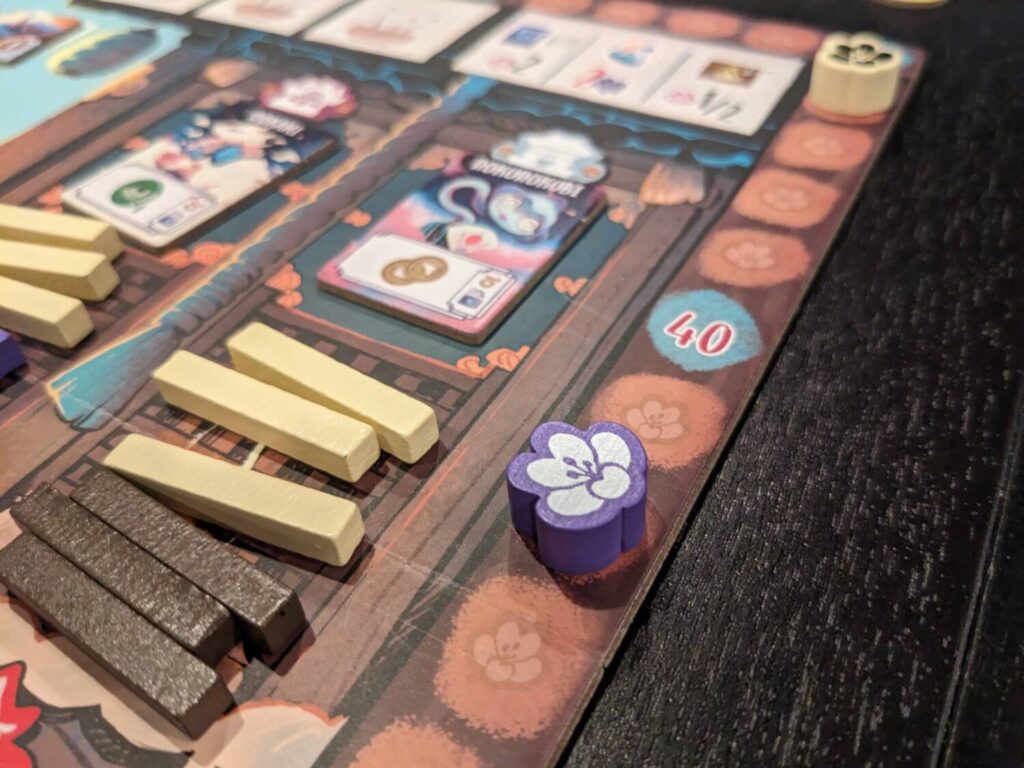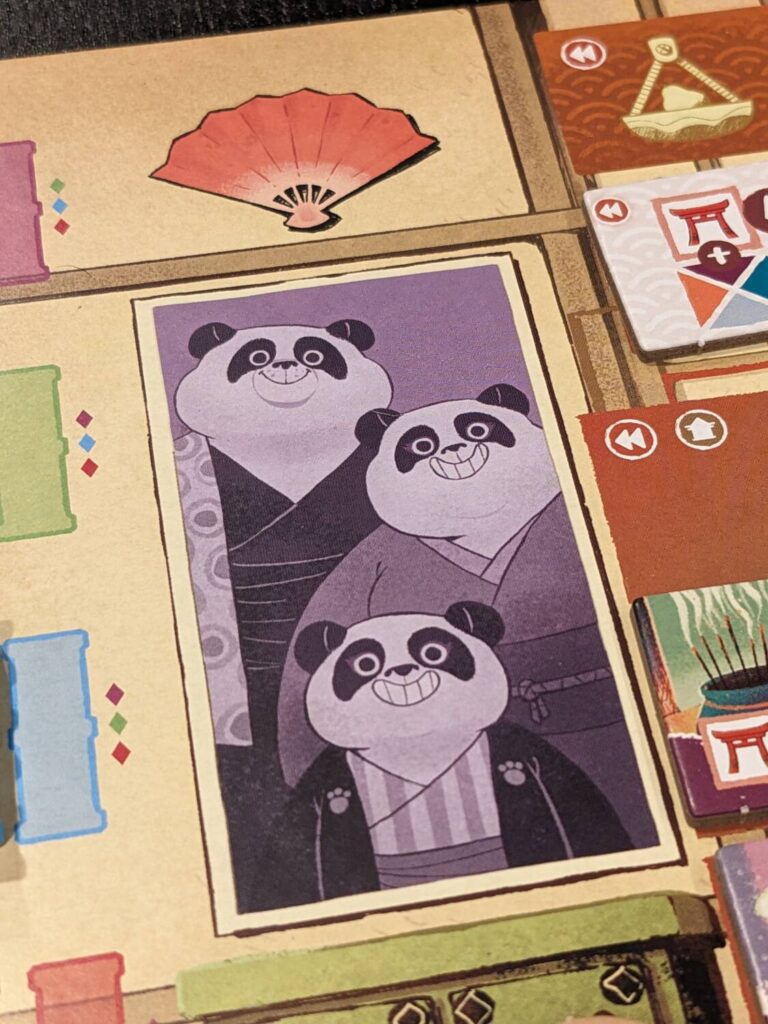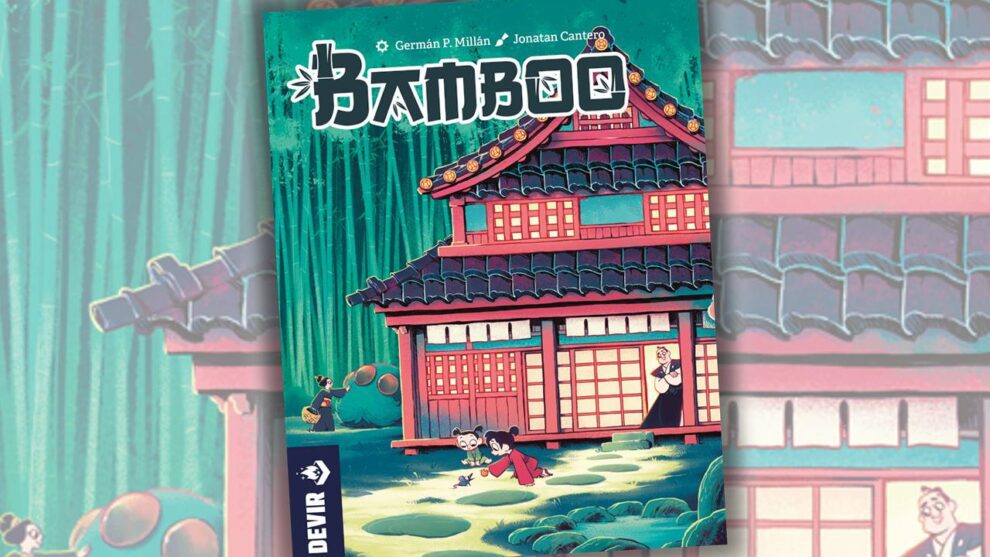Disclosure: Meeple Mountain received a free copy of this product in exchange for an honest, unbiased review. This review is not intended to be an endorsement.
I’m the kind of guy that likes to have a lot of 60-minutes-or-less game options in my quiver. That’s because I’m married to a partner who is usually open to games on a Friday night that last for about an hour. After that, you can begin to see the shiftiness setting in. “When can we do something else?” the eyes start saying after the first glass of wine.
Our partners at Devir sent a care package recently that included their 2023 release Bamboo. After reading the rules, I had a good feeling that this would work well for my wife because the playtime looked short (well under an hour for two players) and the rules could be taught in about ten minutes.
I was right on most fronts. Bamboo is a competitive, yet peaceful, tile-laying puzzle designed by Germán P. Milián, the man behind some games that I’ve really enjoyed over the last year or so: Sabika and Bitoku, the latter with the Resutoran expansion. Both of these previous games are much more complex than Bamboo, so I was curious to see how Bamboo would play with a lighter ruleset that could accommodate casual players and strategy gamers looking for an appetizer.
Bamboo’s production is perfectly Devir: exceptional, save for a rulebook that was only so-so. Let’s talk about the gameplay and the audience it seems best suited to entertain.

Incense Sticks
Bamboo accommodates 2-4 players…so, in a minor surprise for a medium-box game from Devir, there is no solo option in Bamboo. Each player manages a personal player board representing the home of their family, and by the end of the game, the board will have lots of home tiles that require care and feeding in order to achieve the proper amount of balance during end-game scoring.
Over the course of four rounds, players try to score the most points (known here as “Happiness Points”) by using a clever selection system to trigger one of the game’s four main actions: grabbing coins, gathering food to feed the people of your home, buying Home tiles, and selecting Balance tiles. Balance tiles are order fulfillment tokens that score when players take an action to satisfy the conditions listed on the tile, aligned with the layout of the Home tiles on a player’s board.
The action selection mechanism is cool. Players possess a certain number of incense sticks each round, beginning with four in round one. On their turn, a player must select one or more sticks and place them on a temple space. Then, players must take all the bamboo shoots from their player board matching the color of the temple, and take as many actions as incense sticks placed, up to four on a single turn.
The placement area of each temple doubles as an area control mechanic without being too complicated. At the end of a round, the player with the most incense in a temple—with ties broken by whoever went to the temple last—earns a bonus tile that can be used to take an action later in the game and score points at the end of play.
I really enjoyed the way shoots are used to both take actions as well as claim new shoots for future turns. Because players can’t use the same temple on back-to-back turns, plotting how shoots are added back to the player board is a quick and interesting decision. (Each bamboo shoot comes in one of four colors and with only one of the game’s five actions printed on it—the base four actions plus a wild action.)

That meant setting up my next turn was important, but not back-breaking. It is also fun and a tactile pleasure to slide the shoots into their groove on the lower left portion of the main board.
The tile-laying puzzle is elevated beyond the normal exercises I see in games like this because of the balance requirements. The player board is split into 15 spaces for Home tiles along a five-column, three-row design. Balance tiles require that certain tiles be on the left, right, or sometimes anywhere in your Home area. Trying to get the right patterns when buying new Home tiles is a game in and of itself, but thankfully the tile choices in the market are limited to eight at a time and gated by increasing costs.
Usually, I found myself with Balance tiles with very specific requirements and only three or four coins with which to go shopping for new Home tiles on a turn. That really limited which tiles I could buy, so it never felt like the game would break while I stared at the board to make a buying decision. This keeps play moving, unless you are sitting with more deliberate decision makers at the table.
So, Bamboo is pleasing, easy to teach, breezy with lower player counts, and very easy to score. The end-game scoring is tied mainly to the number of unique bonus tiles earned from temples and totaling up the value of the Home tiles to ensure that the left and right sides of your player board are in balance.
Despite these superlatives, I’m surprised to report that the game has only earned above-average scores from the players who have joined me at the table. Everyone likes it, but no one loves it. That makes Bamboo recommended reading, but not required.

“The Elevated Shoulder Shrug”
Bamboo is good, and the best part about the game is that it doesn’t do anything wrong.
The gameplay is solid, yet unspectacular, although as a production, Bamboo is stellar. (There is one thing that really snowed me and my fellow players: why is there so much money included in the game? I never had more than six coins in my possession at any point during any game, but there’s maybe 100 coins’ worth of currency included here. For whom???)
When my wife finished our two-player games (I did two plays at two players, and a third play with three players for this review), I asked her for her thoughts.
“I thought it was good. I’m not sure I would play it again unless you wanted to play it.” This is a typical response from her, but then she continued: “Nothing about it really wowed me. It’s a good choice for our Friday night games because it’s short, but I would rather play something else like—” before naming a bunch of the other games we have in our two-player collection, some of which are Devir Games productions such as The Red Cathedral or The White Castle.

Sometimes, we finish games with my review crew and after asking everyone what they think, I see the Basic Shoulder Shrug. “Meh”, this look seems to say. “Take it or leave it”, that shrug of the shoulders seems to say.
The Elevated Shoulder Shrug is usually accompanied with something akin to a murmur. A sound that players make when I ask them what they think, sort of like the sound you make when you get the gnocchi at a new Italian place and you are surprised by the quality of the sauce. “Hmm, tasty, but I didn’t see that extra boost coming!” your lowered voice seems to say. “Sure, it’s just pasta, but pasta and that little something extra makes me think that we should eat here again!”
It’s not “WOW!!”; it’s more like “OK, I see what you did there!” That’s not a bad thing, but it does mean that you are more likely to not go back to that restaurant if you can get a table at the Italian place that really does make you say “WOW!!”
And that’s Bamboo. It’s good. It’s a game that you should play on the advanced player board side with your strategy gaming friends, and the basic side with your “muggle” friends. It’s not as strong as Milián’s work with Bitoku or Sabika, but I’m not sure Bamboo was destined for Best Game of All Time territory, and I can live with that. I’m keeping Bamboo in my collection for now, but I can already see a future without it, and I can live with that too.











